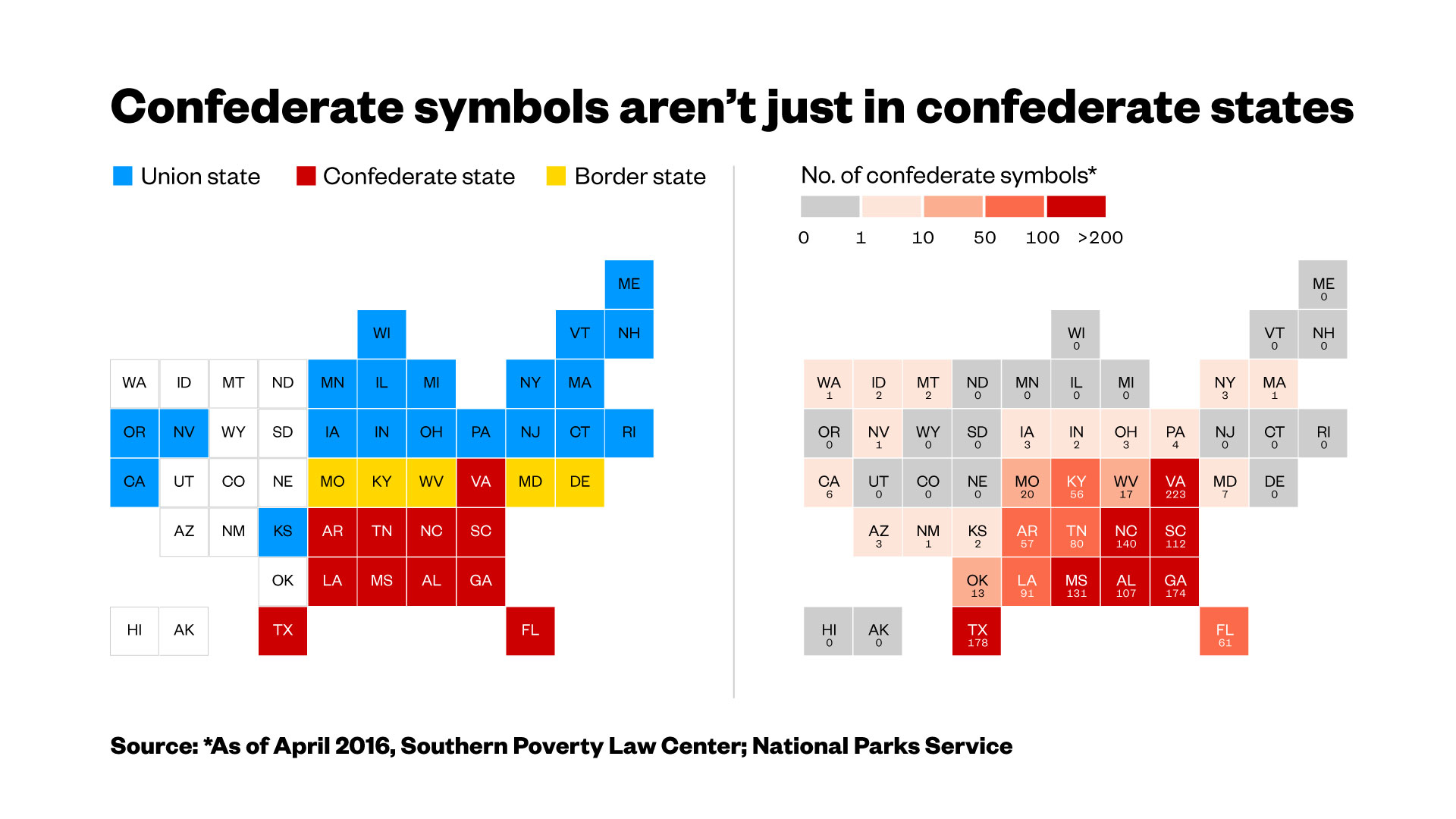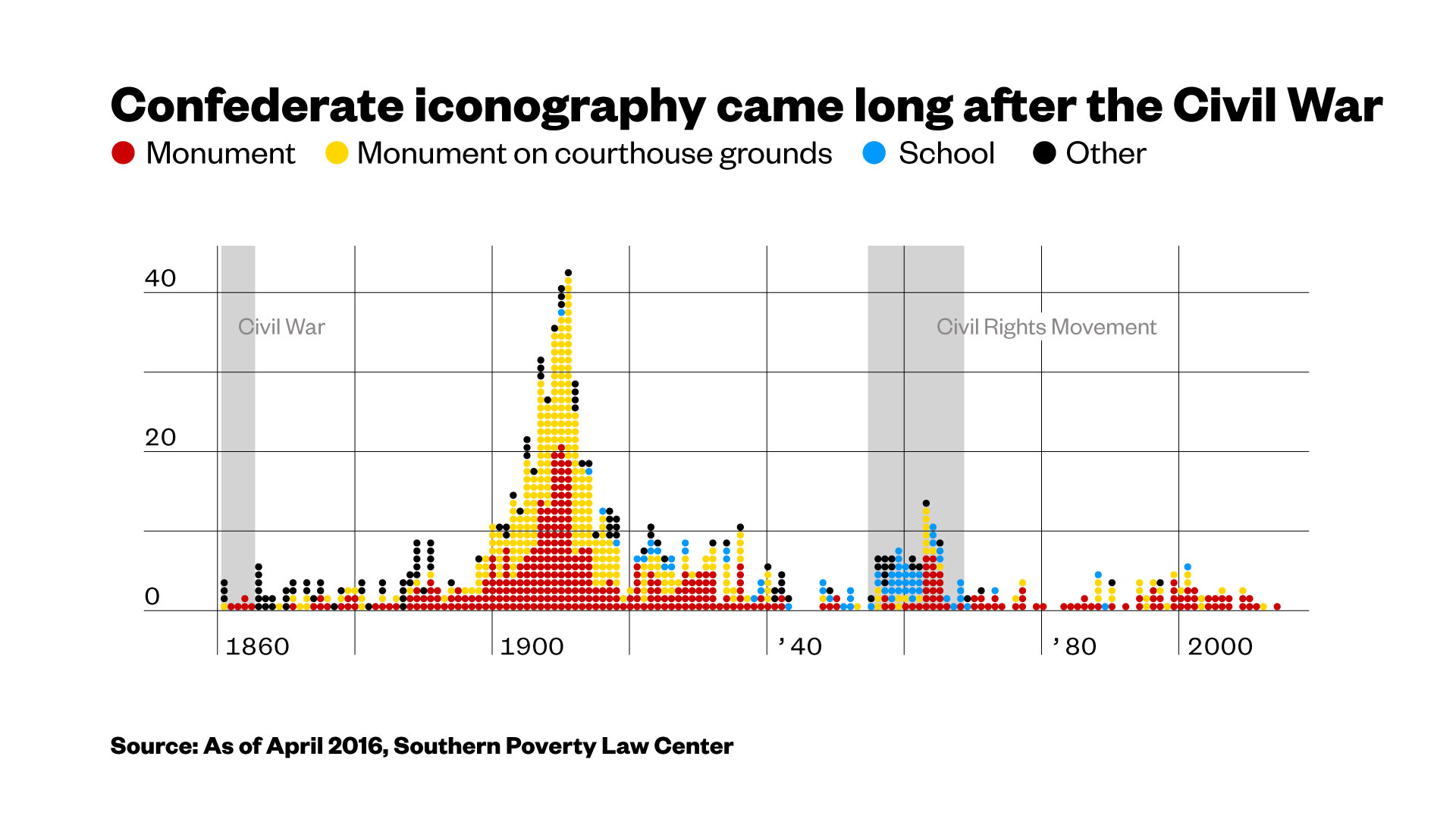The inscription on the Confederate Memorial Fountain in Helena, Montana, says it “sits in longing tribute to our Confederate soldiers.” But there are a few things wrong with the monument, a granite fountain erected in 1916 by the United Daughters of the Confederacy: Montana didn’t have any Confederate dead. It didn’t have any Union dead. That’s because there was no Montana during the Civil War.
Helena’s fountain isn’t alone. As of 2016, at least 22 of the over 1,500 Confederate memorials scattered across the United States sit in areas that weren’t even part of the U.S. when the Confederacy existed, according to the Southern Poverty Law Center. Dozens more live in states that operated under split governments during the Civil War, like Kentucky, which contributed half as many Confederate soldiers as Union soldiers to the fighting but which now hosts 56 Confederate memorials and just two Union ones (the mayor of Lexington, Kentucky, is taking steps to remove two Confederate statues from the city).
Videos by VICE
But the existence of these monuments is less a testament to what actually happened in the Civil War or the heritage of the Confederacy than the fervor to rewrite the telling of the war decades after, when a flurry of monument-building filled the landscape with landmarks, even where they have a dubious connection to actual history.
“There was a really big systematic push to promote the history of the Confederacy and the so-called ‘‘lost cause’ that was largely engineered by women’s groups like the United Daughters of the Confederacy, which had a very overt and systematic plan to rewrite textbooks, to erect public monuments that would establish the ‘true’ history of the war,” said Kirk Savage, an expert on Confederate monuments and their role in collective memory.

The statue of Confederate General Robert E. Lee at the center of last weekend’s violence in Charlottesville is one of three remaining statues dedicated solely to Lee (the others are in Richmond, Virginia, and Mariana, Arkansas), while hundreds more roads, parks, bridges, and schools bear his name. “We like to see symbols of our own heritage,” said Frank Earnest, chief of Heritage Defense at the Virginia division of the Sons of Confederate Veterans.
But if these statues truly symbolize “heritage, not hate,” how did they make their way even into states without a clear Confederate legacy? And why are there hundreds of monuments dedicated to a side that, after all, lost the war?
“Every historical marker, everything we put up on the landscape, is a tale of two eras – at least – it’s a tale of what it’s about, in this case the Civil War, and it’s a tale of when it went up,” said James W. Loewen, a historian and author of “Lies My Teacher Told Me: Everything Your High School History Textbook Got Wrong.”

Most Confederate memorials were established between the 1890s and 1940s, a period Loewen describes as the nadir of race relations. With the slavery question decided politically but racism in society left largely unchanged, the defeated South embarked upon a project to alter the Civil War’s retelling, and in the process divorce the root conflict from its legacy of white supremacy.
As the U.S. spread westward, so too did this version of events: a war fought over the question of states’ rights, to preserve economic profit, in which the moral issue of slavery was just incidental. What also spread was a reality in which part of rebuilding a broken nation meant erecting statues of defeated generals on horseback (a posture generally reserved for victors), which would come to function as shrines to a history of deadly racism.
General Lee, sensitive to the war’s painful consequences, cautioned against a push toward monument building. “I think it wise… not to keep open the sores of war, but to follow the examples of nations who endeavoured to obliterate the marks of civil strife,” he responded to an 1869 invitation for a meeting to discuss a memorial at Gettysburg, the war’s bloodiest battle and the one that dealt Lee’s troops a crippling defeat.
While debates over the future of Confederate monuments roil communities, experts say the conflicts could be a turning point for how America handles the lasting impact of this schism. “It seems like we reached a point in the middle of this decade where the connection between a long history of white supremacy, and injustice in the present, finally clicked. And that throws all of these monuments into question, because that’s what they represent,” Savage said.
In Loewen’s view, the statues should be relocated to a dedicated area where citizens can gather to reckon with history. “Charlottesville has enough Confederate statues for an entire park, and it could be a park about the nadir of race relations, with historical markers that explain why these things went up between 1890 and 1940, what was going on, and why they came down in 2017 to 2020. Or however long it takes.”
Alex Stockton contributed reporting.
This video segment originally aired August 16, 2017, on VICE News Tonight on HBO.
More
From VICE
-

Screenshots: Saber Interactive Inc, Rose City Games -

(Photo by Patrick McDermott/Getty Images) -

Birdlkportfolio / Getty Images -

Screenshot: Electronic Arts
